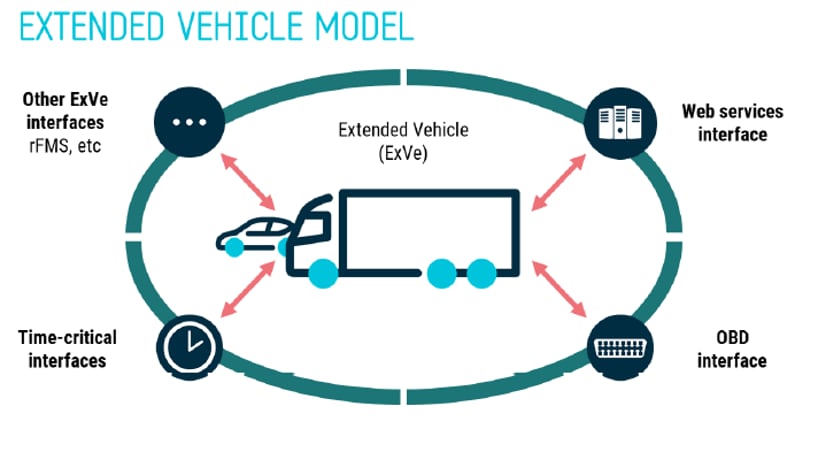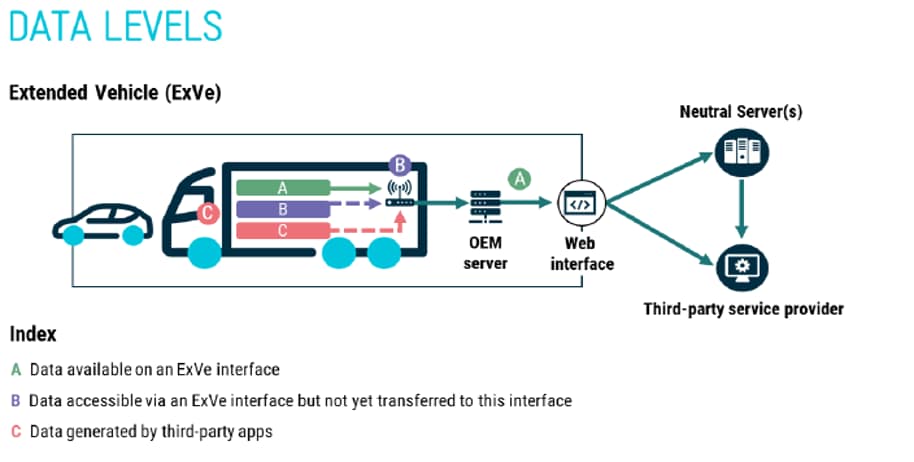,allowExpansion)
Cadre réglementaire européen pour les véhicules connectés
Découvrez le règlement sur les véhicules étendus, en particulier l'accès et le partage des données à bord des véhicules.
Aujourd'hui, les utilisateurs de véhicules veulent utiliser les fonctions utiles de leur smartphone et les intégrer dans leur véhicule. Les cas d'utilisation de l'échange de données sur les véhicules peuvent accroître le confort et la commodité pour les clients, améliorer les produits et les services et contribuer à la réalisation d'objectifs sociétaux. Il s'agit notamment d'améliorer la sécurité routière, de réduire la consommation de carburant et de faciliter la gestion du trafic ainsi que les possibilités de stationnement. Cette évolution a entraîné une augmentation des demandes d'accès et d'utilisation de données embarquées provenant de tiers. Les clients ont utilisé un grand nombre de ces cas d'utilisation.
Les réglementations concernant l'accès aux données embarquées devraient être fondées sur une compréhension claire et précise du fonctionnement d'un véhicule, de la manière dont les données sont générées et de la manière dont l'accès est rendu possible sur une interface de véhicule, quel que soit le niveau de données prises en compte.
Moyens d'accès
Vehicle manufacturers have started to deploy the Extended Vehicle model and believe that the technology used for accessing data is based on the best practices in the industry. This is underpinned by the key principles of driver safety and security. They regard that the ISO Extended Vehicle model satisfies the FRAND principle: fair, reasonable, and non-discriminatory access to in-vehicle data. The Extended Vehicle makes it possible to access vehicle data through a number of interfaces that can be used depending on the type of access requested:

Niveaux de données
Les points de données disponibles diffèrent selon le constructeur automobile et le niveau d'équipement du véhicule de chaque client. Dans cette optique, le schéma suivant décrit les approches permettant d'accéder aux données pertinentes en fonction des demandes de la tierce partie.
L'image ci-dessous illustre les niveaux de données, fournissant une représentation visuelle de la façon dont l'accessibilité des données varie en fonction de différents facteurs.

Les données du véhicule sont disponibles sur le backend du fabricant du véhicule (OEM) via l'interface Extended Vehicle sélectionnée par le fabricant.
Le niveau B correspond aux données qui peuvent être rendues accessibles via une interface véhicule étendue, mais qui n'ont pas encore été transférées vers cette interface.
Il s'agit de données générées par des applications et hébergées dans l'unité de contrôle électronique (ECU) d'un véhicule. Ces applications peuvent être utilisées pour agréger et traiter les données d'embarquement.
Procédure de demande d'accès au données
Lorsqu'une partie prenante souhaite fournir un service utilisant les données ou les ressources d'un véhicule par voie hertzienne, un processus clair doit être mis en place pour que le fournisseur puisse soumettre sa demande au constructeur automobile concerné. À cette fin, l'ISO (TC22/SC31/WG 6 Extended Vehicle) finalise un projet de rapport technique intitulé : "Road vehicle - Extended Vehicle - Upstream process to develop services" (Véhicule routier - Véhicule étendu - Processus en amont pour développer des services).
Ce rapport technique décrit un processus permettant d'initier et de faciliter la communication entre les fournisseurs de services et les constructeurs automobiles. Ce faisant, les fournisseurs de services expriment leurs demandes d'accès aux données et aux ressources des interfaces du véhicule étendu pour développer des services.
Conclusion
Un véhicule n'est pas un smartphone sur roues, ni un ordinateur personnel qui peut être redémarré en cas de problème pendant la conduite. En outre, il ne s'agit pas d'une plateforme logicielle dont l'objectif principal est de générer, de traiter, de partager et de recevoir des données. D'un point de vue technique, le transfert de points de données supplémentaires nécessite de profondes modifications de l'architecture physique et du logiciel du véhicule, ce qui augmentera la puissance de calcul du véhicule. Ces mesures ont un impact significatif sur l'optimisation des ressources et sur l'environnement.
Toute initiative politique concernant l'accès aux données des véhicules pour des services tiers doit prendre en considération ces limitations et les conséquences qu'elles peuvent avoir sur la capacité d'un client à choisir le véhicule qui répond le mieux à ses besoins.